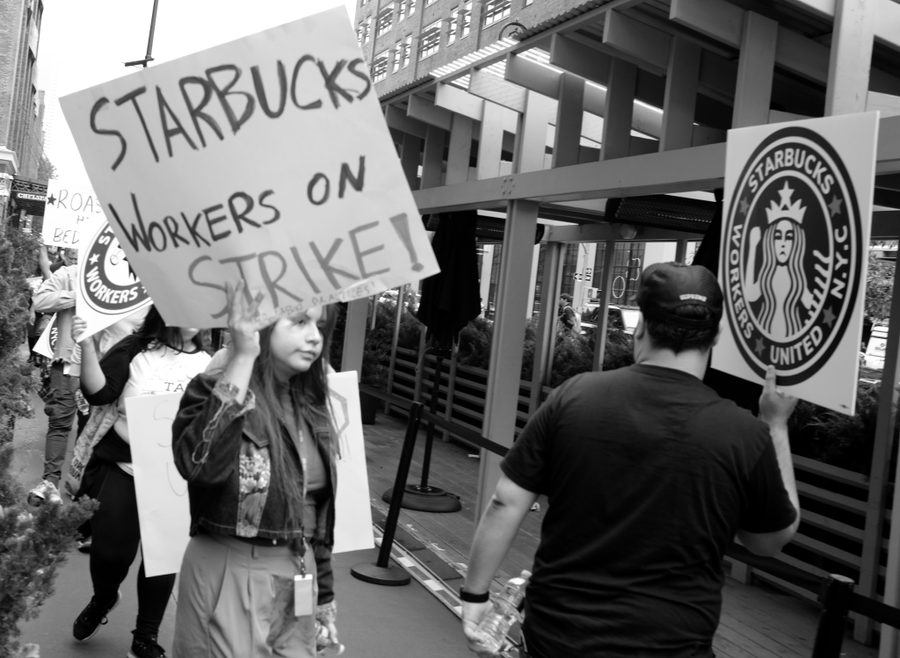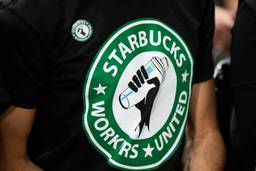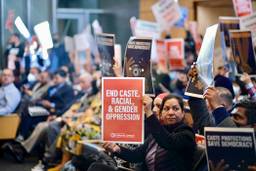Black Mold, Bed Bugs and Anti-Union Tactics: Why New York Starbucks Workers Are Out On Strike
Starbucks workers at a roastery in New York are on the picket line alleging unsafe working conditions and a refusal by management to bargain in good faith.
Saurav Sarkar

On Tuesday morning, 10 workers at Starbucks’ upscale Reserve Roastery in Manhattan, New York walked off the job, alleging unsanitary work conditions including bed bugs and black mold, as well as union busting by management.
“Nobody wants to be in a building where management is lying to us, keeping us in the dark, where we clearly have a big bed bug infestation. Nobody wanted to be there,” says 27-year-old Nicole DeRose, an employee at the store who was on shift when the strike began.
Starbucks Media Relations said in an email to In These Times that it became aware of a “potential pest issue” on Monday and called a pest control service that found no evidence of an infestation and “gave…the all-clear to re-open on Tuesday.” The company said in the email that “the store was treated to prevent any potential future issues as a precautionary measure.”
But DeRose claims a manager had told her that Starbucks had known about the bed bug infestation since Saturday, despite subsequent denials from other managers. And according to DeRose, at least one of her coworkers had marks on his chest on Tuesday that, based on Internet searches by the workers, appeared to resemble bed bug bites, but he had not yet confirmed the diagnosis at the time of their search. DeRose says that as her coworker left the roastery, a manager said, “If you walk outside, that’s a mistake.”
The Starbucks’ workers claim that the situation demonstrated the company’s lack of willingness to speak plainly with its workers and address issues in a forthright manner.
“We were asking many questions like, ‘Where do we put our stuff? Where am I supposed to leave my bag if I’m not allowed to leave it in the break room because there’s bed bugs in there.’ And they said, ‘We don’t know,’” says DeRose.
She adds, “We asked for brand new, clean aprons. They didn’t have clean aprons for us. They were trying to find any random aprons for us to use. It was just a very disorganized day and that was insulting enough,” she says.
Joel Foote, a 23-year-old worker at the roastery, who was not on shift Tuesday, joined the picket after getting a call from one of his coworkers as the line reached about 20 people, including community supporters and union allies.
Foote says, “the mold situation has been going on for months now” with a “very old ice machine” that produces ice for the store.
“All of that ice has been frequently spotted to have mold, or some kind of black substance, growing on the inside of the machine,” says Foote. He adds, “It’s in the various components of the machine. It’s all over the ice.”
Foote says that the ice is used throughout the store, including for drinks like $20 espresso martinis and beverages served in the upstairs cocktail bar.
Another store employee, Laura Garza, 22, told Patch that the strike was over “health and safety issues that we have been dealing with ever since winning our union vote in April. This includes a moldy ice machine that we are not equipped to properly remediate, and which are still in current use, as well as the more recent situation with bed bugs being found in the Roastery.”
Starbucks Media Relations said in the same email that “every ice machine undergoes thorough cleaning at routine intervals” and that “Roastery store management [had] discovered a wiring issue with one machine and had the unit replaced within 48 hours” last week.
Elsewhere, the company stated that a vendor had found no operational or cleanliness concerns with the machine last month, but the company had replaced it nonetheless.
Foote says he was among the workers who was asked to clean the substance from the ice machine and says that he, like the two who had done so before him, got “immediately sick.” Foote claims he was ill for three weeks, with symptoms like a sore throat, constant coughing and a runny nose.
According to Starbucks Media Relations, the company “welcome[s] any partners to raise health and safety concerns with store management to ensure a swift resolution.”
“I wish I could afford the coffee that I serve. We sell a coffee drink at our store that’s priced at $17. That’s what [I] make an hour,” says DeRose.
Foote says that the workers’ frustrations that led to the walkout were not solely the result of this latest health scare, but also of a series of moves by management. These include allegedly unilaterally changing duties for back-of-the-house workers who prepped food to also clean bathrooms, as well as a change in hours for some “partners” (as Starbucks refers to employees) who were suddenly asked to come in at 4:30 am, several hours earlier than their previous shift times.
The walkout at the roastery comes on the heels of a momentous year of labor organizing at the coffee behemoth.
Since December 2021, over 250 company-run Starbucks locations in the United States have unionized. On April 1 of this year, the Manhattan roastery became the first Starbucks store in New York City to unionize and the tenth in the country overall. However, workers say that they have since struggled to get the company to the table to bargain in good faith, though they did secure a legal settlement earlier in October.
This obstruction by management when it comes to bargaining reflects a wider national trend. Until late September, the company largely refused to bargain with workers while it engaged in a heated union-busting campaign, including firing over 100 union leaders and tailoring wage and benefit policies to slow the enthusiasm for unionization. The company even accused the National Labor Relations Board (NLRB) of secretly assisting the union and called for a suspension in pending mail-in union elections.
Through late September, management was at the table with only three stores’ unions despite repeated attempts by Starbucks Workers United (SBWU), the workers’ network behind the organizing effort, to get the company to the table. In the last week of September, Starbucks finally inched toward bargaining with most stores, abruptly sending out letters to representatives offering a three-week bargaining window in October.
Starbucks says that it has reached a mutual agreement to bargain at 40 locations with Workers United, SBWU’s parent union, and negotiations started on Monday. However, the company has since filed five Unfair Labor Practice charges against Workers United because the union was virtually including SBWU members not physically present at the negotiations at five locations. It also alleged that the union had recorded and posted online portions of the negotiations from at least one negotiation.
For its part, Workers United on Tuesday filed a national ULP complaint alleging that Starbucks is still refusing to bargain in good faith at 152 locations, including the Reserve Roastery in Manhattan.
To date, the NLRB has alleged over 800 violations of federal labor law by Starbucks.
At the Reserve Roastery, while four workers remained working in the store on Tuesday, workers say Starbucks was forced to call in salaried workers because of a lack of staff throughout the day. These included a facilities manager who was spotted doing dishes, an events coordinator working the merchandise section, and a shift scheduler who was restocking and cleaning, says DeRose.
“It was actually very telling to see that there are many times where we are overworked on the floor, drowning on the floor, super long lines, and managers don’t come to assist us…and then today, all of a sudden they know how to make a drink,” she says.
Workers at the store remained on strike as of Friday.







